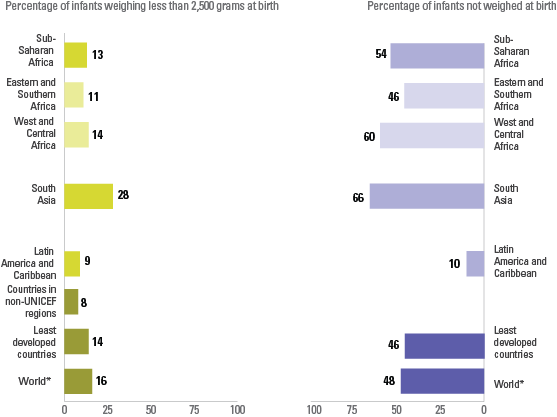A baby’s weight at birth is a strong indicator of maternal and newborn health and nutrition. Being undernourished in the womb increases the risk of death in the early months and years of a child’s life. Those who survive tend to have impaired immune function and increased risk of disease; they are likely to remain undernourished, with reduced muscle strength, cognitive abilities and IQ throughout their lives. As adults, they suffer a higher incidence of diabetes and heart disease.
The incidence of low birthweight, defined as the proportion of newborns weighing less than 2,500 grams, is monitored through both health system surveillance and household surveys. In 2013, nearly 22 million newborns—an estimated 16 per cent of all babies born globally that year—had low birthweight. Accurate monitoring is challenging, however, since nearly half of the world’s infants are not weighed at birth.

Improving Child Nutrition: The achievable imperative for global progress
This report builds on earlier findings on the impact of undernutrition by highlighting new developments and demonstrating that efforts to scale up nutrition programmes are working, benefiting children in many countries.

Birthweight is the first weight of the newborn obtained after birth. For live births, birthweight should preferably be measured within the first hour of life, before significant post-natal weight loss has occurred.
Low birthweight is defined as less than 2,500 grams (up to and including 2,499 grams).
THE INDICATOR
The indicators presented on this page, ‘incidence of low birthweight’ and ‘children not weighed at birth’ are defined in the table below.
|
Indicator name |
Definition |
|
|---|---|---|
|
Numerator |
Denominator |
|
|
Incidence of low birthweight |
The number of live births in a given population and over a given time period that weigh less than 2,500 grams |
Total number of live births in the given population during the same period |
|
Children not weighed at birth |
The number of live births in a given population and over a given time period for which the birthweight is unknown |
Total number of live births in the given population during the same period |
DATA SOURCES
For industrialized countries, the main sources of information on low birthweight are service-based data and national birth registration systems. For developing countries, low-birthweight estimates are primarily derived from national household surveys, as well as data from routine reporting systems.
ADJUSTMENT PROCEDURES FOR HOUSEHOLD SURVEY DATA
Globally, nearly half of all babies are not weighed at birth. Moreover, those that are tend to be better off (more likely to be born in health facilities, urban areas and of better-educated mothers), which can lead to an underestimation of low-birthweight incidence. To complicate matters even further, when infants are weighed at birth, the readings tend to cluster around multiples of 100 grams. As a result, a certain proportion of infants whose birthweights are reported as exactly 2,500 grams actually weigh less than 2,500 grams. This would suggest further underestimation of low-birthweight incidence. Prior to acceptance in UNICEF’s global database, household survey data from MICS and DHS are adjusted to account for under-reporting and misreporting of birthweights using methods published by Blanc and Wardlaw (2005). The assumptions implicit in this adjustment are the following:
- Births with numerical birthweights reported are as likely to be low birthweight as those without reported birthweights
- Within the same country, the relationship between birthweight and the mother’s assessment of infant size does not depend on whether the infant was weighed.
It should be noted, however, that adjusted rates may still underestimate the true magnitude of the problem. It is critical, therefore, that all babies be properly weighed at birth.


